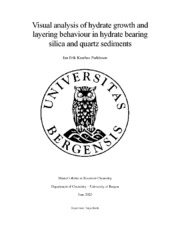Visual analysis of hydrate growth and layering behaviour in hydrate bearing silica and quartz sediments
Master thesis

Permanent lenke
https://hdl.handle.net/1956/23482Utgivelsesdato
2020-08-05Metadata
Vis full innførselSamlinger
- Master theses [170]
Sammendrag
Gas hydrates are crystalline solids with cage-like structures of water containing a guest molecule. They have sparked great interest due to their potential as an energy source, and the possibility of utilizing them for carbon capture and storage. In the North Sea, natural gas hydrates are found dispersed in fine grained sediments. Most previous laboratory studies on hydrates in sediments have focused on formation in coarse-grained sediments and intrapore hydrate behaviour. More research is therefore required on hydrate formation behaviour fine-grained sediments. This thesis presents a study on macroscopic hydrate formation behaviour in colloidal silica and fine-grained quartz sediments. Tetrahydrofuran (THF) is used as hydrate former in place of methane, as it forms hydrates at atmospheric pressure. The formation of hydrates is recorded by a camera over a span of 24 to 48 hours, and colouring is used to enhance visibility. A range of experiments are set up to observe hydrate growth within varying environmental conditions, such as electrolyte content and porosity. Magnetic resonance imaging (MRI) is also used to observe hydrate formation behaviour from within samples. Hydrates were observed to form nodes, veins, channels and layers in colloidal silica and fine-grained quartz sediments. The formation behaviour was seen to depend on reaction kinetics. Slow hydrate formation saw the build-up of larger hydrate crystals, while fast hydrate growth saw a fine dispersion of hydrates with less tendency to displace sediments. Colloidal suspensions saw a more complete and dispersed hydrate growth, while larger but fewer hydrate structures were observed in the more dense sediments. Utsira formation water with an electrolyte content of roughly 3,2 weight percent was also seen to greatly enhance hydrate growth, despite its salt content. Due to the COVID-19 pandemic, planned experiments using Equinor’s MRI instrument had to be cancelled. Only a few images were therefore extracted. These images provide the methodology for the MRI experiments, and provide evidence that hydrate layering behaviour is also prevalent within the undisturbed sediments.
Utgiver
The University of BergenOpphavsrett
Copyright the Author. All rights reservedBeslektede innførsler
Viser innførsler beslektet ved tittel, forfatter og emneord.
-
Methane Production from Natural Gas Hydrates. Impact of Temperature on CH4 -CO2 Exchange rate in Hydrate Bearing Sandstone
Håheim, Truls Hamre (Master thesis, 2013-06-17)Dissociation by pressure depletion, thermal stimulation and/or injection of inhibitors are three known methods for gas production from natural gas hydrates. Challenges concerning these production methods are water and sand ... -
Cyclopentane Hydrate for Hydrate Wetting Studies
Abdulkader, Bashir Mohammed Hissen (Master thesis, 2013-06-03)Abstract Gas hydrates are often found in the systems for production of petroleum, natural gas and water systems, which is highly undesirable. In some systems the hydrates can form rapidly into large plugs and agglomerate ... -
Effects of salinity on hydrate stability and implications for storage of CO2 in natural gas hydrate reservoirs
Husebø, Jarle; Ersland, Geir; Graue, Arne; Kvamme, Bjørn (Peer reviewed; Journal article, 2009-02)The win-win situation of CO2 storage in natural gas hydrate reservoirs is attractive for several reasons in addition to the associated natural gas production. Since both pure CO2 and pure methane form structure I hydrate ...